 Mitsubishi Outlander: Supplemental restraint system (SRS)-airbag
Mitsubishi Outlander: Supplemental restraint system (SRS)-airbag
The information for SRS airbags includes important information concerning the driverŌĆÖs and front passengerŌĆÖs airbags, the side airbags and the curtain airbags. The SRS airbags are designed to supplement the primary protection of the driver and front passenger side seat belt systems by providing those occupants with protection against head and chest injuries in certain moderate-to-severe frontal collisions. A dual-stage airbag system is used where the SRS airbags for the driverŌĆÖs and front passengerŌĆÖs seats are controlled with impact sensors (on the front of the vehicle and in the centre of the vehicle floor). The SRS side airbags (if so equipped) are designed to supplement properly worn the seat belts and provide the driver and front passenger with protection against chest and abdomen injuries in certain moderate-to-severe side impact collisions. The SRS curtain airbags (if so equipped) are designed to supplement properly worn the seat belts and provide the driver and passenger with protection against head injuries in certain moderate- to-severe side impact collisions. The SRS is NOT a substitute for the seat belts. To ensure the maximum protection during all types of collisions and accidents, all occupants, including the passengers as well as the driver, must wear their seat belts.
How the supplemental restraint system works
The SRS includes the following components:
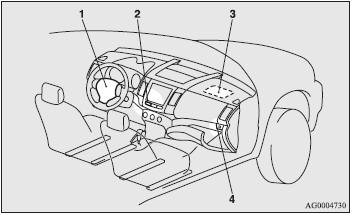
1- Airbag module (Driver). 2- Front passengerŌĆÖs airbag off indicator lamp. 3- Airbag module (Passenger). 4- Front passengerŌĆÖs airbag ON-OFF switch.
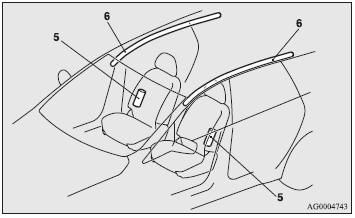
5- Side airbag modules*. 6- Curtain airbag modules*.
The airbags will operate only when the ignition switch is in the ŌĆ£ONŌĆØ or ŌĆ£STARTŌĆØ position. The airbags deployment produces a sudden, loud noise, and releases some smoke and powder, but these conditions are not injurious, and do not indicate a fire in the vehicle. People with respiratory problems may feel some temporary irritation from chemicals used to produce the deployment; open the windows after airbag deployment, if safe to do so. The airbags deflate very rapidly after deployment, so there is little danger of obscured vision.
CAUTION:
● Airbags inflate at an extremely rapid speed. In certain situations, contact with
inflating airbags can result in abrasions bruises, and the like.
WARNING:
● IT IS VERY IMPORTANT TO BE PROPERLY SEATED. A driver or front passenger too close
to the steering wheel or instrument panel during airbag deployment can be killed
or seriously injured. Airbags inflate very fast, and with great force. If the driver
and front passenger are not properly seated and restrained, the airbags may not
protect you properly, and could cause serious or fatal injuries when it inflates.
● Do not sit on the edge of the seat, or lean head or chest close to the steering
wheel or instrument panel. Do not put feet or legs on or against the instrument
panel.
● Place all infants and small children in the rear seat and properly restrained
using an appropriate child restraint system. The rear seat is the safest for infants
and children.
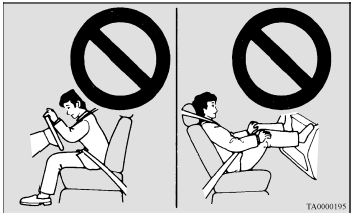
WARNING:
● Infants and small children should never be unrestrained, stand up against the
instrument panel or held in your arms or on your lap. They could be seriously injured
or killed in a collision, including when the airbag inflates. They should be properly
seated in the rear seat in an appropriate child restraint system. See the ŌĆ£Child
restraintŌĆØ section of this ownerŌĆÖs manual.
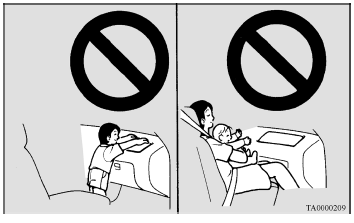
Use rearward facing child restraints in the rear seat or turn off the front passengerŌĆÖs airbag ON-OFF switch (refer to ŌĆ£To turn an airbag offŌĆØ on page 2-59).
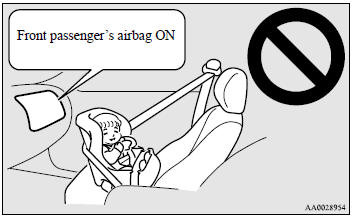
WARNING:
● A REARWARD FACING CHILD RESTRAINT must NOT be used in the front passenger seat
if the front passengerŌĆÖs airbag has not been deacivated. The force of an inflating
airbag could kill or cause serious injuries to the child. A rearward facing child
restraint should be used in the rear seat.
● A FRONTWARD FACING CHILD RESTRAINT should be used in the rear seat whenever possible;
if they must be used in the front passenger seat, adjust the seat to the most rearward
position. Failure to do so could kill or cause serious injuries to the child.
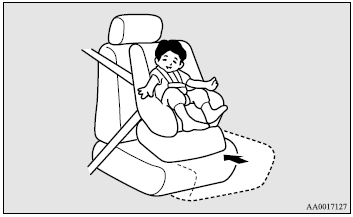
WARNING:
● Older children should be seated in the rear seat, properly wearing the seat belt,
with an appropriate booster seat if needed.
Caution for installing the child restraint on vehicle with front passenger airbag
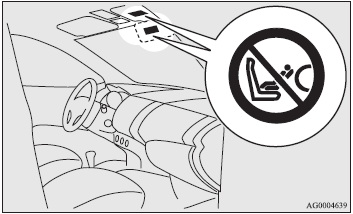
The label shown here is attached on vehicles with front passenger airbag.
WARNING:
● Extreme Hazard! Do not use a rearward facing child restraint on a seat protected
by an airbag in front of it!
Front passengerŌĆÖs airbag ON-OFF switch
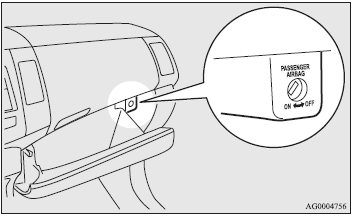
The front passengerŌĆÖs airbag ON-OFF switch can be used to disable the front passengerŌĆÖs airbag. If you have a rearward facing child restraint system that cannot be fitted to any seat other than the front passenger seat, be sure to turn OFF the front passengerŌĆÖs airbag ON-OFF switch before using it (refer to ŌĆ£To turn an airbag offŌĆØ on page 2-59). Front passengerŌĆÖs airbag ON-OFF switch is located in the glove box.
Front passengerŌĆÖs airbag off indicator lamp
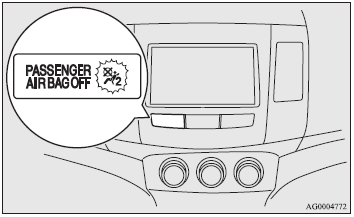
The front passengerŌĆÖs airbag off indicator is located in the instrument panel.
The indicator normally comes on when the ignition switch is turned to the ŌĆ£ONŌĆØ position, and goes off a few seconds later. When the front passengerŌĆÖs airbag ON-OFF switch is turned OFF, the indicator will stay on to show that the passenger front airbag is not operational. When the front passengerŌĆÖs airbag ON-OFF switch is turned ON, the indicator goes off to show that the front passengerŌĆÖs airbag is operational.
WARNING:
● Do not fit any accessory that makes the indicator impossible to see, and do not
cover the indicator with a sticker. You would not be able to verify the status of
the passenger airbag system.
To turn an airbag off
WARNING:
● To reduce risk of serious or fatal injury: ŌĆó Always remove the key from the ignition
switch before operating an airbag ON-OFF switch. Failure to do so could adversely
affect the airbag performance. ŌĆó Wait at least 60 seconds to operate the airbag
ONOFF switch after turning the ignition switch from ŌĆ£ONŌĆØ position to ŌĆ£LOCKŌĆØ position.
The SRS airbag system is designed to retain enough voltage to deploy the airbag.
ŌĆó Always remove the key from an airbag ON-OFF switch after operating that switch.
Failure to do so could lead to improper position of the airbag ONOFF switch. ŌĆó Do
not turn OFF the front passengerŌĆÖs airbag ONOFF switch except when a rearward facing
child restraint system is fitted to the front passenger seat. ŌĆó If the indicator
does not come on when the front passengerŌĆÖs airbag ON-OFF switch is turned OFF,
do not fit a rearward facing child restraint system to the front passenger seat.
We recommend you to have the system inspected by a MITSUBISHI MOTORS Authorised
Service Point. ŌĆó If the indicator remains on when the front passengerŌĆÖs airbag ON-OFF
switch is turned ON, do not allow anyone to sit on the front passenger seat. We
recommend you to have the system inspected by a MITSUBISHI MOTORS Authorised Servic
Point.
To turn an airbag off, follow these steps: 1. Insert the key into the airbag ON-OFF switch, and turn that to the ŌĆ£OFFŌĆØ position. 2. Remove the key from the key opening of that airbag ONOFF switch. 3. Insert the key into the ignition switch, and turn the ignition to ŌĆ£ONŌĆØ position. The front passengerŌĆÖs airbag off indicator lamp will stay on.
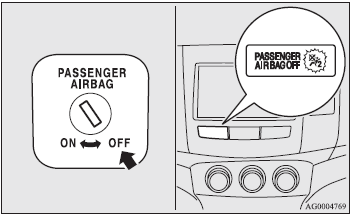
The airbag off indicator lamp should illuminate. The front passengerŌĆÖs airbag is now deactivated and will not deplay until switched on again.
DriverŌĆÖs and passengerŌĆÖs front airbag system
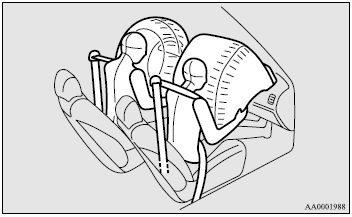
The driverŌĆÖs airbag is located under the padded cover in the middle of the steering wheel. The front passengerŌĆÖs airbag is contained in the instrument panel above the upper glove box. The driver airbag and the front passenger airbag are designed to inflate at the same time even if the passenger seat is not occupied. The driverŌĆÖs airbag inflates at two different rates according to the fore-aft position of the driverŌĆÖs seat and the severity of the impact. The front passengerŌĆÖs airbag deploys at the same time as the driverŌĆÖs airbag, even if the passenger seat is not occupied, and inflates at two different rates according to the severity of the impact.
Deployment of front airbags
The front airbags ARE DESIGNED TO DEPLOY whenŌĆ”
The front airbags are designed to deploy when the vehicle suffers a moderate to severe frontal impact. Examples of some typical conditions are shown in the illustration.
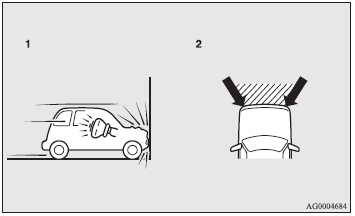
1- Head-on collision with a solid wall at speed of approximately 25 km/h (16 mph) or higher. 2- Moderate to severe frontal impact within the shaded area between the arrows.
The front airbags will deploy if the severity of impact is above the designed threshold level, comparable to an approximately 25 km/h (16 mph) collision when impacting straight into a solid wall that does not move or deform. If the severity of the impact is below the above threshold level, the front airbags may not deploy. However, this threshold speed will be considerably higher if the vehicle strikes an object that absorbs the impact by either deforming or moving (for example, another stationary vehicle, pole or a guard rail). Because frontal collisions can easily move you out of position, it is important to always properly wear your seat belts. Your seat belts will help keep you a safe distance from the steering wheel and instrument panel during the initial stages of airbag deployment. The initial stage of airbag inflation is the most forceful, and can possibly cause serious or fatal injuries. Moreover, the seat belts in your vehicle are your primary means of protection in a collision. The SRS (Supplemental Restraint System) airbags are designed to provide additional protection. Therefore, for your safety and the safety of all occupants, be sure to always properly wear your seat belts.
The front airbags MAY NOT DEPLOY whenŌĆ”
With certain types of frontal collisions, the vehicleŌĆÖs body structure is designed to absorb the shock to help protect the occupants from harm (the vehicle bodyŌĆÖs front area may deform significantly as it absorbs the impact). Under such circumstances, the front airbags may not deploy irrespective of the deformation and damage to the vehicle body. Examples of some typical conditions are shown in the illustration.
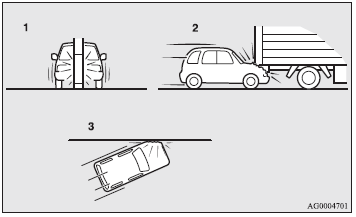
1- When colliding with a utility pole, tree or other narrow object. 2- Vehicle slides under the rear body of a truck. 3- Oblique frontal impacts.
Because the front airbags do not protect the occupant in all types of frontal collisions, be sure to always properly wear your seat belts.
The front airbags ARE NOT DESIGNED TO DEPLOY whenŌĆ”
The front airbags are not designed to deploy in conditions where they cannot typically provide protection to the occupant. Such conditions are shown in the illustration.
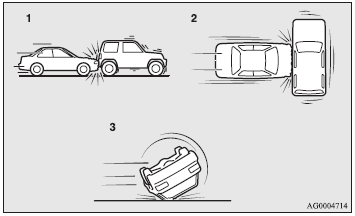
1- Rear end collisions. 2- Side collisions. 3- Vehicle rolls onto its side or roof.
Because the front airbags do not protect the occupant in all types of collisions, be sure to always properly wear your seat belts.
The front airbags MAY DEPLOY whenŌĆ”
The front airbags may deploy if the bottom of the vehicle suffers a moderate to severe impact (undercarriage damage). Examples of some typical conditions are shown in the illustration.
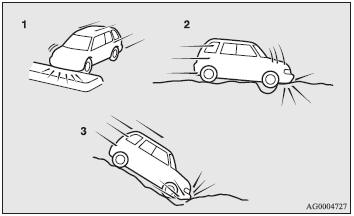
1- Collision with an elevated median/island or curb. 2- Vehicle travels over a deep hole/pothole. 3- Vehicle drives down a steep slope and hits the ground.
Because the front airbags may deploy in certain types of unexpected impacts as shown in the illustration that can easily move you out of position, it is important to always properly wear your seat belts. Your seat belts will help keep you a safe distance from the steering wheel and instrument panel during the initial stages of airbag deployment. The initial stage of airbag inflation is the most forceful and can possibly cause serious or fatal injuries if you contact it at this stage.
WARNING:
● Do not attach anything to the steering wheelŌĆÖs padded cover, such as badges or
accessories. It might strike and injure an occupant if the airbag inflates.
● Do not set anything on, or attach anything to, the instrument panel above the
glove box. It might strike and injure an occupant if the airbag inflates.
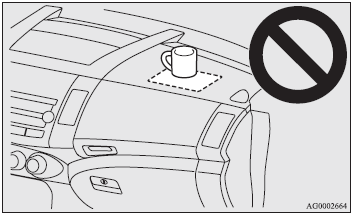
WARNING:
● Do not attach accessories to, or put them in front of, the windscreen. These objects
could restrict the airbag inflation, or strike and injure an occupant if the airbags
inflate.
● Do not put packages, pets or other objects between the airbags and the driver
or front passenger. It could affect airbag performance, or could cause injury when
the airbag inflates.
● Right after the airbag inflation, several airbag system components will be hot.
Do not touch these components. There is a danger of being burnt.
● The airbag system is designed to work only once. Once the airbags have deployed,
they will not work again. They must promptly be replaced, and the entire airbag
system inspected, by an authorised MITSUBISHI dealer.
Side airbag system*
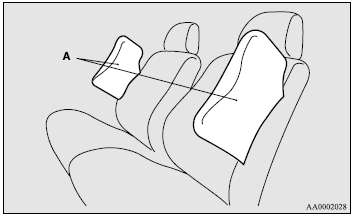
The side airbags (A) are contained in the driver and front passenger seatbacks. The side airbag is designed to inflate only on the side of the vehicle that is impacted, even with no passenger in the front seat.
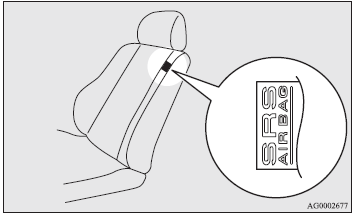
The label shown here is attached to the seatbacks with a side airbag.
Curtain airbag system*
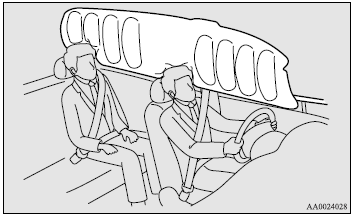
The curtain airbags are contained in the front pillars and roof side rail. The curtain airbag is designed to inflate only on the side of the vehicle that is impacted, even with no passenger in the front seat or second seat.
Deployment of side airbags and curtain airbags
The side airbags and curtain airbags ARE DESIGNED TO DEPLOY when...
The side airbags and curtain airbags are designed to deploy when the vehicle suffers a moderate to severe side impact to the middle of the passenger compartment. The typical condition is shown in the illustration.
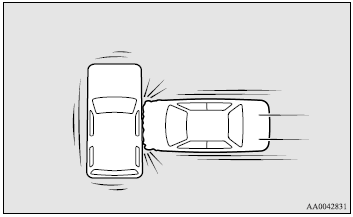
The seat belts in your vehicle are your primary means of protection in a collision. The SRS (Supplemental Restraint System) side airbags and curtain airbags are designed to provide of all occupants, be sure to always properly wear your seat belts.
The side airbags and curtain airbags MAY NOT DEPLOY when...
With certain types of side collisions, the vehicleŌĆÖs body structure is designed to absorb the shock to help protect the occupants from harm (the vehicle bodyŌĆÖs side area may deform significantly as it absorbs the impact). Under such circumstances, the side airbags and curtain airbags may not deploy irrespective of the deformation and damage to the vehicle body. Also, depending on the location of the impact, the side airbags and curtain airbags may not deploy simultaneously. Examples of some typical conditions are shown in the illustation.
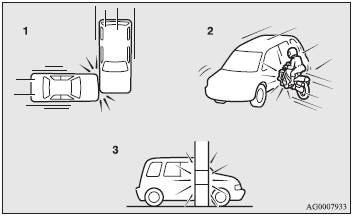
1- Side impacts in an area away from the passenger compartment. 2- Motorcycle or other similar small vehicle collides with the side of vehicle. 3- Collision with a utility pole, tree or other narrow object.
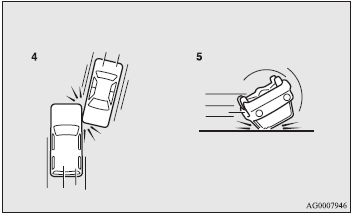
4- Oblique side impacts. 5- Vehicle rolls onto its side or roof.
Because the side airbags and curtain airbags do not protect the occupant in all types of side collisions, be sure to always properly wear your seat belts.
The side airbags and curtain airbags ARE NOT DESIGNED TO DEPLOY when...
The side airbags and curtain airbags are not designed to deploy in conditions where they cannot usually provide protection to the occupant. Typical conditions are shown in the illustration.
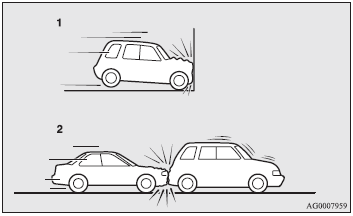
1- Head-on collisions. 2- Rear end collisions.
Because the side airbags and curtain airbags do not protect the occupant in all types of collisions, be sure to always properly wear your seat belts.
WARNING:
● The side airbags and curtain airbags are designed to supplement the driver and
passenger seat belts in certain side impacts. Seat belts should always be worn properly,
and the driver and passenger should sit well back and upright without leaning against
the window or door.
● The side airbags and curtain airbags inflates with great force. The driver and
passenger should not put their arms out the window, and should not lean against
the door, in order to reduce risk of serious or possible fatal injury from the deploying
side airbags and curtain airbags.

WARNING:
● Do not allow any second seat occupant to hold onto the seatback of either front
seat, in order to reduce risk of injury from the deploying side airbags. Special
care should be taken with children.
● Do not place any objects near or in front of the seat - back of either front seat.
They could interfere with proper side airbag inflation, and also could cause injury
if thrown free by side airbag deployment.
● Do not place stickers, labels or additional trim on the seatback of either front
seat. They could interfere with proper side airbag inflation.
● Do not install seat covers on seats with side airbags. Do not re-cover seats that
have side airbags. This could interfere with proper side airbag inflation.
● Do not attach a microphone (A) or any other device or object around the part where
the curtain airbags (B) activate such as on the windscreen, side door glass, front
and rear pillars and roof side or assist grips. When the curtain airbags inflate,
the microphone or other device or object will be hurled with great force or the
curtain airbags may not activate correctly, resulting in death or serious injury.

WARNING:
● Do not put a hanger or any heavy or pointed object on the coat hook. If the curtain
airbag was activated, any such item could be propelled away with great force and
could prevent the curtain airbag from inflating correctly. Hang clothes directly
on the coat hook (without using a hanger). Make sure there are no heavy or sharp
objects in the pockets of clothes that you hang on the coat hook.
● Never install a rearward facing child restraint in the front passenger seat. A
forward facing child restraint should be used in the rear seat only when ever possible.
If a forward facing child restraint must be used in the front passenger seat, adjust
the seat to the most rearward position, and use care to ensure that the child stays
in the child restraint and away from the door.
● Do not allow the child to lean against or close to the front door even if the
child is seated in a child restraint system. The childŌĆÖs head should also not be
leaned against or be close to the area where the side airbags and curtain airbags
are located. It is dangerous if the side airbags and curtain airbags inflate. Failure
to follow all of these instructions could lead to serious or fatal injury to the
child.
● Work around and on the side airbags and curtain airbags system components should
only be done by an authorised MITSUBISHI MOTORS dealer.
SRS warning lamp/display

The warning lamp/display illuminates when there is a fault with the system. In addition, ŌĆ£SERVICE REQUIREDŌĆØ is displayed on the information screen in the multi-information display. Normally, when the ignition switch is turned to the ŌĆ£ONŌĆØ position, the warning lamp should illuminate for several seconds and then should go out. In addition, if an SRS airbag and the pre-tensioner system operate, the warning lamp illuminates and stays on. The SRS warning lamp is shared by the Supplemental Restraint System (SRS) and the seat belt pre-tensioner system.
WARNING E00407900960
● When the warning lamp/display behave as follows, the system could be faulty. The
SRS airbag or pretensioner seat belt might not operate normally during a collision,
etc., resulting in injury, so have them inspected by an authorised MITSUBISHI MOTORS
dealer. ŌĆó The warning lamp does not illuminate or stays illuminated when the ignition
switch is turned ŌĆ£ONŌĆØ. ŌĆó The warning lamp illuminates while driving. ŌĆó The warning
display operates while driving.
SRS servicing
WARNING:
● We recommend any maintenance performed on or near the components of the SRS to
be performed by a MITSUBISHI MOTORS Authorized Service Point. Improper work on the
SRS components or wiring could result in inadvertent deployment of the airbags,
or could render the SRS inoperative; either situation could result in serious injury.
● Do not modify your steering wheel, seat belt retractor or any other SRS components.
For example, replacement of the steering wheel, or modifications to the front bumper
or body structure can adversely affect SRS performance and lead to possible injury.
● If your vehicle has received any damage, we recommend you to have the SRS inspected
to ensure it is in proper working order.
● Do not modify your front seats, centre pillar and centre console. It can adversely
affect SRS performance and lead to possible injury. If you found any tear scratch,
crack or damage to the seat fabric near the side airbag, the portion of the front
and rear pillars and roof side rail, you should have the SRS inspected by a MITSUBISHI
MOTORS Authorised Service Point.
NOTE:
● When you transfer ownership of the vehicle to some other person, we urge you to
alert the new owner that it is equipped with the SRS and refer that owner to the
applicable section in this ownerŌĆÖs manual.
● If your vehicle has to be scrapped do this in line with local legislation and
contact a MITSUBISHI MOTORS Authorised Service Point to safely dismantle the airbag
system.
 Seat belt inspection
Seat belt inspection
● Check the belts for cuts, worn or frayed webbing and for cracked or deformed metallic
parts. Replace the belt assembly if defective.
● A dirty belt should be cleaned with neutral d ...
See also:
Setting a speed
Use the or
buttons set the vehicle's current
speed. The set speed is shown in the display.
NOTE
Cruise control cannot be engaged at
speeds below 20 mph (30 km/h). ...
Steering
Your vehicle is equipped with an electric power-assisted steering (EPAS)
system. There is no fluid reservoir to check or fill.
If your vehicle loses electrical power while you are driving (or if t ...
Other bulbs
It may be difficult to replace the bulbs.
Have the bulbs replaced by your
SUBARU dealer if necessary. ...

